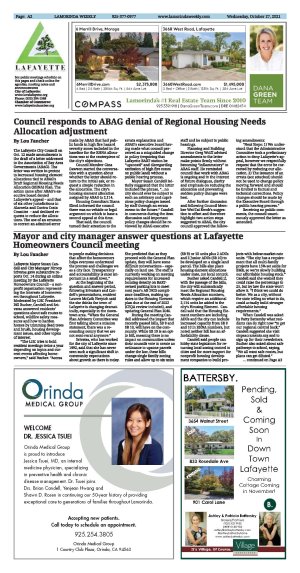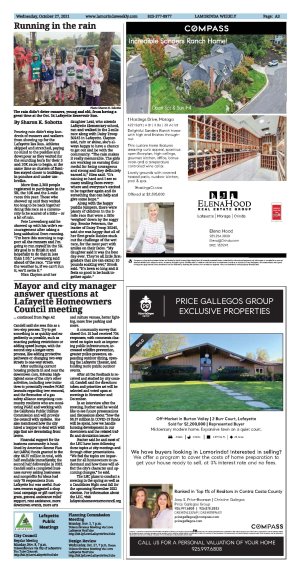| | Published October 27th, 2021
| Mayor and city manager answer questions at Lafayette Homeowners Council meeting
| | | By Lou Fancher | | |
Lafayette Mayor Susan Candell and City Manager Niroop Srivatsa gave substantive reports Oct. 14 during an online meeting by the Lafayette Homeowners Council - a nonprofit organization representing the interests of homeowners throughout Lafayette. Moderated by LHC President Bill Bucher, Candell and Srivatsa answered residents' questions about safe routes to school, wildfire safety measures and how to harden homes by trimming dead trees and brush, housing development issues, and other topics of interest.
 "The LHC tries to hold resident meetings twice a year depending on topics and current events affecting homeowners," said Bucher. "Access to people making decisions that affect the homeowners helps everyone understand the process and challenges we as a city face. Transparency and accountability is most important in a small town." ?
"The LHC tries to hold resident meetings twice a year depending on topics and current events affecting homeowners," said Bucher. "Access to people making decisions that affect the homeowners helps everyone understand the process and challenges we as a city face. Transparency and accountability is most important in a small town." ?
 At the beginning of the question and answer period, following Srivatsa's and Candell's presentations, resident Lauren McCaib Herpich said the she thinks the town of Lafayette is changing dramatically, especially in the downtown area. "When the General Plan Advisory Committee was first talking about a mission statement, there was a resounding outcry that we are not semi-rural anymore."
At the beginning of the question and answer period, following Srivatsa's and Candell's presentations, resident Lauren McCaib Herpich said the she thinks the town of Lafayette is changing dramatically, especially in the downtown area. "When the General Plan Advisory Committee was first talking about a mission statement, there was a resounding outcry that we are not semi-rural anymore."
 Srivatsa, who has worked for the city of Lafayette since 1992, said that she has never seen such a significant shift in community expectations about growth as there is today. She predicted that as they proceed with the General Plan update, they will have some difficult conversations - especially on land use. The staff is currently working on meeting requirements for increased housing density on BART-owned parking lots to meet next year's AB 2923 compliance deadlines, making updates to the Housing Element plan due at the end of 2022 (CEQA review included), and updating General Plan 2040.
Srivatsa, who has worked for the city of Lafayette since 1992, said that she has never seen such a significant shift in community expectations about growth as there is today. She predicted that as they proceed with the General Plan update, they will have some difficult conversations - especially on land use. The staff is currently working on meeting requirements for increased housing density on BART-owned parking lots to meet next year's AB 2923 compliance deadlines, making updates to the Housing Element plan due at the end of 2022 (CEQA review included), and updating General Plan 2040.
 During the meeting Candell addressed the impact that recently passed bills, SB 9 and SB 10, will have on the community. While SB 10 is an opt-in bill, meaning there is no impact on communities unless their councils vote to create an ordinance to upzone parcels under the law, these bills change single family zoning rules and allow up to six units (SB 9) or 10 units plus 2 ADUs and 2 Junior ADUs (SB 10) to be developed on a single land parcel. The bills also place housing element allocations under state, not local control.
During the meeting Candell addressed the impact that recently passed bills, SB 9 and SB 10, will have on the community. While SB 10 is an opt-in bill, meaning there is no impact on communities unless their councils vote to create an ordinance to upzone parcels under the law, these bills change single family zoning rules and allow up to six units (SB 9) or 10 units plus 2 ADUs and 2 Junior ADUs (SB 10) to be developed on a single land parcel. The bills also place housing element allocations under state, not local control.
 Bucher asked Candell if, with the passage of the bills, the city will automatically meet the Regional Housing Needs Allocation numbers, which require an additional 2,114 units be added to the city's Housing Element. Candell said that the Housing Element numbers are including ADUs and the city can include increased capacity from SB 9 and 10 in RHNA numbers, but noted neither bill has an affordability clause.
Bucher asked Candell if, with the passage of the bills, the city will automatically meet the Regional Housing Needs Allocation numbers, which require an additional 2,114 units be added to the city's Housing Element. Candell said that the Housing Element numbers are including ADUs and the city can include increased capacity from SB 9 and 10 in RHNA numbers, but noted neither bill has an affordability clause.
 Candell said people can lobby state legislators for returning local zoning control to cities and for more support for nonprofit housing development companies to build projects with below-market-rate units. "The city has a requirement that all multi-family projects have 15% set aside for BMR, so we're slowly building our affordable housing stock." Candell said she wished they could raise the percentage to 25, but by law the state won't allow it. "I think we could do better. We as a city, without the state telling us what to do, could actually build stronger affordable housing requirements."
Candell said people can lobby state legislators for returning local zoning control to cities and for more support for nonprofit housing development companies to build projects with below-market-rate units. "The city has a requirement that all multi-family projects have 15% set aside for BMR, so we're slowly building our affordable housing stock." Candell said she wished they could raise the percentage to 25, but by law the state won't allow it. "I think we could do better. We as a city, without the state telling us what to do, could actually build stronger affordable housing requirements."
 When Candell was asked by Patty Battersby what residents can do right now "to get our regional control back," Candell suggested she visit stopsacramento.org and to sign up for their newsletters. Bucher also asked about safe pathways to school, saying, "We all want safe routes, but plans can get diluted."
When Candell was asked by Patty Battersby what residents can do right now "to get our regional control back," Candell suggested she visit stopsacramento.org and to sign up for their newsletters. Bucher also asked about safe pathways to school, saying, "We all want safe routes, but plans can get diluted."
 Candell said she sees this as a two-step process: Try to get something in as quickly and expediently as possible, such as enacting parking restrictions or adding speed humps, with the second step a longer-term process, like adding protective pathways or changing two-way streets to one-way streets.
Candell said she sees this as a two-step process: Try to get something in as quickly and expediently as possible, such as enacting parking restrictions or adding speed humps, with the second step a longer-term process, like adding protective pathways or changing two-way streets to one-way streets.
 After outlining current housing projects in and near the downtown core, Srivatsa highlighted some of the city's other activities, including new initiatives to potentially resolve PG&E lawsuits regarding tree removal, and the formation of a gas safety alliance comprising community residents who are monitoring PG&E and working with the California Public Utilities Commission and will provide the council with updates. She also mentioned how the city hired a trapper to deal with wild pigs that are devastating front lawns.
After outlining current housing projects in and near the downtown core, Srivatsa highlighted some of the city's other activities, including new initiatives to potentially resolve PG&E lawsuits regarding tree removal, and the formation of a gas safety alliance comprising community residents who are monitoring PG&E and working with the California Public Utilities Commission and will provide the council with updates. She also mentioned how the city hired a trapper to deal with wild pigs that are devastating front lawns.
 Financial support for the business community is headlined by American Rescue Plan Act (ARPA) funds granted to the city: $6.37 million in total, with half available immediately; the second half deliverable in 2022. Candell said a completed business survey asking businesses and nonprofits for ideas had only 78 respondents from Lafayette but was useful. Business owners suggested a shop local campaign or gift card program, general assistance relief support, rent assistance, more downtown events, more arts and culture venues, better lighting, more free parking and more.
Financial support for the business community is headlined by American Rescue Plan Act (ARPA) funds granted to the city: $6.37 million in total, with half available immediately; the second half deliverable in 2022. Candell said a completed business survey asking businesses and nonprofits for ideas had only 78 respondents from Lafayette but was useful. Business owners suggested a shop local campaign or gift card program, general assistance relief support, rent assistance, more downtown events, more arts and culture venues, better lighting, more free parking and more.
 A community survey that closed Oct. 25 had received 734 responses, with comments clustered on topics such as improving public infrastructure, increased wildfire prevention, greater police presence, expanding outdoor dining, opening the Lafayette Theater, and holding more public outdoor events.
A community survey that closed Oct. 25 had received 734 responses, with comments clustered on topics such as improving public infrastructure, increased wildfire prevention, greater police presence, expanding outdoor dining, opening the Lafayette Theater, and holding more public outdoor events.
 After all the feedback is received and studied by city council, Candell said the directions taken and priorities set will be selected and voted upon at meetings in November and December.
After all the feedback is received and studied by city council, Candell said the directions taken and priorities set will be selected and voted upon at meetings in November and December.
 In an interview after the meeting, Bucher said he would like to see future presentations and discussions about "how the $6.37 million in COVID-19 funds will be spent, how we handle housing development in our downtown and the related traffic and circulation issues."? Bucher said he and most of the LHC have been following these topics at city meetings and through other presentations. "We feel the topics are important for all homeowners to understand and how these will affect the city's character and upcoming changes," he said.
In an interview after the meeting, Bucher said he would like to see future presentations and discussions about "how the $6.37 million in COVID-19 funds will be spent, how we handle housing development in our downtown and the related traffic and circulation issues."? Bucher said he and most of the LHC have been following these topics at city meetings and through other presentations. "We feel the topics are important for all homeowners to understand and how these will affect the city's character and upcoming changes," he said.
 The LHC plans to conduct a meeting in the spring as well as a Candidates Night next fall for the upcoming November 2022 election. For information about the LHC, visit www.lafayettehomeownerscouncil.org
The LHC plans to conduct a meeting in the spring as well as a Candidates Night next fall for the upcoming November 2022 election. For information about the LHC, visit www.lafayettehomeownerscouncil.org |
| | | | | | | | | | | | |



